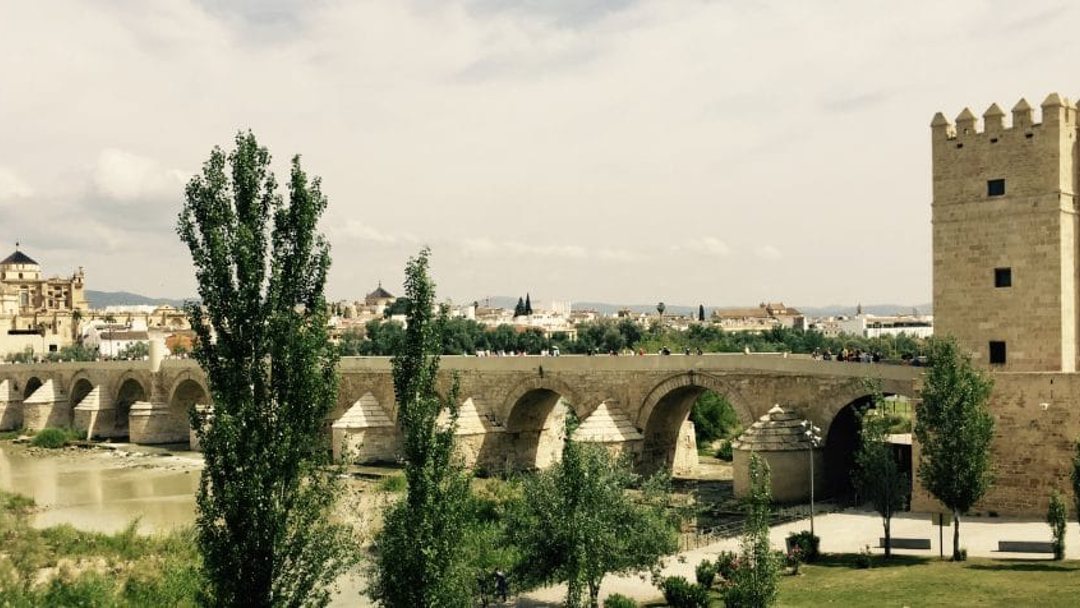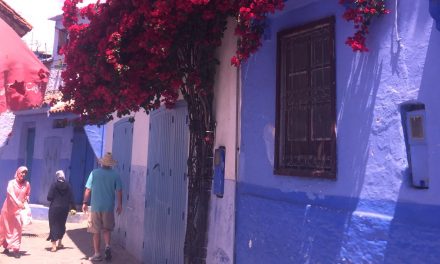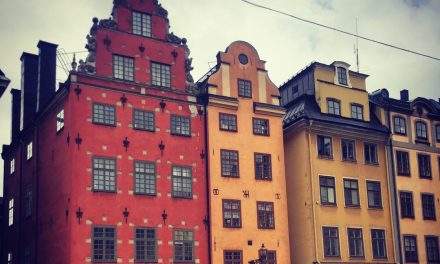We decided to visit the Mezquita at Córdoba, the renowned world heritage Mosque/Cathedral, on a Sunday during our 2 weeks in Alorà.
In a short time we had traversed a few smaller roads and were on the A-45, an excellent dual lane freeway. The median strip was populated with the ever present oleanders, but this time they were a mixture of cream, pink and crimson, providing a relaxing break from the traffic. The freeway took us through a diverse landscape, large rolling valleys, huge jagged rocky outcrops of oranges and greys, deep valleys and vast plains. But one thing seemed common to all; olive groves. They are everywhere. Neat rows flow on as far as the eye can see, sometimes interspersed with almond trees or, as we neared Córdoba, more often vineyards. It was about 2 hours drive before Córdoba emerged and what a delight it turned out to be.
After crossing the Rio Guadalquivir via the Puente Abbäs Ibn Firnäs, a stunning modern bridge, and passing through a relatively small amount of outer suburbs, we emerged onto the Avenue Conde de Vallellano, which is simply gorgeous, surrounded as it is by beautiful gardens on either side. On our first pass, we managed to miss the turn off and ended up crossing the river before doubling back and turning into the byzantine network of small streets leading to the Mezquita car park, which wouldn’t you know it, was full. It seems that everyone likes to travel visit the Mezquita on Sunday and we had arrived just in time for Sunday Mass which may not have been the wisest decision. It perhaps should have occurred to us that, in very Catholic Spain, Sunday might be busy. Extricating ourselves from the network of back streets took some patience, but we eventually emerged back onto the Conde de Vallellano, crossed back over the bridge, took a left turn or two and then managed to locate a gravel and dirt car park, the Parking Cordoba Caravana, which is right next to the river and only a block from the Puente Romano, the ancient bridge which crosses directly to the Mezquita. More a case of good luck than judgement, but as it turned out it was well worth the €5, a bargain compared to the €15 at the Mezquita.
We ambled along the river past the Calahorra Tower and crossed the Roman Bridge originally built in the 1st century BC, but reconstructed during the 8th century by the Moors. It is only open to foot traffic now and was a delightful way to arrive at the Mezquita through the Triumphal Arch, the Puerta del Puente.
From the outside, the Mezquita is a vast sandstone edifice, crawling with tourists. Who are we to complain? We are of that ilk also, if perhaps a little, well a lot more crowd wary.
We had arrived late in the morning and as we knew were too late for the early morning visit, so we elected to stroll the surrounding area and return for the 3:00 pm visit. We walked along beside high stone walls and then turned the corner and strolled up the Calle del Mesón del Sol. From this side we could see a number of huge bronze or golden doors set into intricately decorated Moorish archways. The carvings are a testament to the patience and skills of ancient craftsmen and must have taken an enormous amount of work. So often it is the tiny details these amazing buildings that knock you out. A little further along, we came to an open archway which led us through into the Mezquita courtyard, the Patio De Los Naranjos, a cobbled area full of orange trees and a few enormous palms, all watered by an intricate network of irrigation channels

Not the Calleja de las Flores but very pretty
As we had some time to kill, we decided to explore the rest of the old town and headed off toward the Calleja de las Flores, reputedly one of the most beautiful streets in Cordoba, thanks to its floral displays. Alas the Calleja was decorated with tourists, all bent on having themselves photographed in front of the place. As soon as one was finished, another would take their place and it quickly became evident that there was no chance of us capturing a photo. We also suspected they may have been eating the aforementioned herbiage, as there didn’t appear to be that many flowers, although on reflection it may have been that we arrived a little late in the season.
As we continued on through the old town, we saw many beautiful buildings and monuments, another beautiful town that is easy to wander without purpose. One of the delights of travelling in a slower way, is not having to rush to sites or meet the bus, traveller’s nirvana. The stairs and bougainvillea display at Cuesta del Bailio were a delight and we suspect much prettier than the aforementioned Calleja, as was the gold and blue tiled depiction of the Madonna at the top, in the Plaza de los Capuchinos, which to Ian’s dismay didn’t in fact lead to a coffee house.

Colours of Cordoba
After a good long walk about the old town, we started looking for lunch and eventually found a pleasant little bar, the Taberna el Abuelo, where we sat down to a couple of cold beers and some interesting tapas. Whilst the tapas were mostly very average, Ian thoroughly enjoyed the fried black pudding, which we have found is not confined to the UK. In fact we have subsequently found there are a number of great varieties in Spain, much to Cath’s distaste.
After dining we wended our way back through the shopping district around Plaza de las Tendillas and eventually back to the Mezquita. It is here that we must make a confession. We sat waiting for the ticket office to open for half an hour, electing not to stand in the lengthening queue in the blazing sun, but eventually realised that we had left it too late and departed without actually going in. We know it was a poor choice, but in our defence, we have to say the size of the queue and the lateness of the day made it an easy one. We left Córdoba with a promise to return and spend a few days. It is far too pretty a city to see in one day. We’ll be back!
And we will book tickets to the Mezquita in advance, we hear on the grapevine that a few weeks in advance might be the just the ticket.
If you or someone you know like this please like and share using the social media buttons below.
If you would like more information or to give us some tips on Cordoba please comment below or contact us.








Cordoba seems like a definitely worth visiting place which I soon hope to cross off my bucket list! When’s the best time of the year to explore it?
Hi Agness, thank you for your question. We were in Cordoba in May/June and the weather was quite warm and there were a few tourists around. We think it would be beautiful in late March and April just before the hot weather starts and all the flowers are out. It should be less busy and you might even get an off season discount! We hope you enjoy your trip. Happy Travels
I was planning to go to Cordoba this May as a day trip from Madrid but then decided I shall leave it for some other time (when I go to Seville for example) as it was quite far from Madrid, so was interested in reading this and appreciated sharing your experience!
Hi Monika, it is a long way from Madrid and the south is so nice to linger in for a little while. We hope you can get there soon, it was a lovely place to wander.Happy Travels
Your description is very nice. I can almost feel it!
Cordoba is very beautiful. I liked how they plant flowers on the walls and in the balconies and make the surrounding look and smell pleasant.
Hi Trupti, thank you for your comments, the flowers and gardens are stunning, aren’t they?
I love how these older cities are able to incorporate flowers and plants so easily into everyday life, it must be great to see green and splashes of colour instead of monotonous grey every where!
Hi Frankie, thank you for your comments, Spain in late spring is just flowers everywhere, so very beautiful. Happy Travels